Plantscape Fairview Collecting for Christmas Cards for Troops Again

Here is a View"
"The Coffee that Won the West"
On the trail, coffee was made by throwing a fistful of coffee beans into boiling water over a campfire. Tradition said if the cook threw a horseshoe into the pot and it sank, the coffee was not ready to drink.
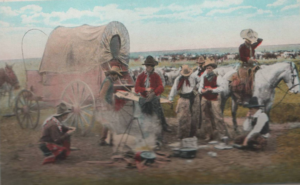
Cowboys at breakfast. HCHM Postcard Collection
The Cowboy's Coffee
Until the close of the Civil War, coffee was sold green. Beans had to be roasted on a wood stove or in a skillet over a campfire before it could be ground and brewed. One burned bean ruined the entire batch.
In 1865, John Arbuckle and his brother Charles, discovered a new way to process coffee beans. By roasting and coating the coffee beans with an egg and sugar glaze, they were able to to seal in the flavor and aroma. Shipped all over the country in sturdy wooden crates, one hundred packages to a crate, Arbuckles' Ariosa Coffee was a big success with chuck wagon cooks on cattle drives.
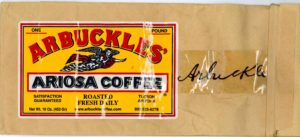
"Who Wants the Candy?"
In addition to coffee beans, each package of Arbuckles' contained a stick of peppermint candy. This was considered a treat for the cowboy who got the tedious job of grinding the coffee beans. Upon hearing the cook's call, "Who wants the candy?" some of the toughest cowboys on the trail were known to vie for the opportunity of manning the coffee grinder in exchange for satisfying a sweet tooth.
After grinding the beans, a pot was filled two thirds full with cold water. Over an open fire the water was brought to a roiling boil. Then, a pound of Arbuckles was added. The pot was allowed to slow boil for several minutes before serving.
Today, Arbuckles Ariosa Coffee, including the peppermint treat, is still available at Arbucklecoffee.com.
History Under Foot
by Kristine Schmucker, HCHM Curator
While finishing up Christmas shopping last week, I happened to look down as I left one of the stores along Newton's Main Street.
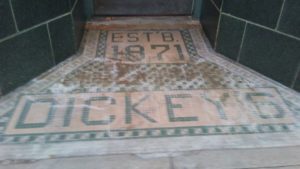
December 2017
Repairs were underway and the top layer in the entry way had been removed and a piece of history was revealed.

611 Main, detail, 2007
Today, the building is home to the Main Street Company, a clothing store. Originally, this building, with the fun architectural details, was Dickey's Drug & Jewelry.
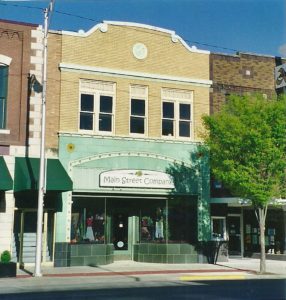
611 Main, Newton, Ks, 2007
John B. Dickey was born in Michigan in 1848. John, "having a liking for the drug business, learned his profession in Centerville, Mich" where his father was a practicing physician. At the age of 22, Dickey headed to Kansas and settled first in Wichita where he worked as an "assistant postmaster." He began to hear about a proposed town north of Wichita and the adventures of a cattle drive. He resigned his job to herd cattle. While working as a cowboy, he contracted malaria. He went to the new drug store in Newton owned by W.P. Pugh for quinine. He argued with Pugh over the high price of the drug. The argument ended with Dickey buying the business paying a monthly rent of $65 to Pugh for the small wood frame building. In June 1871, he opened "Dickey's Drug" in Newton. A year later, building was destroyed by fire, but Dickey's Drug continued.
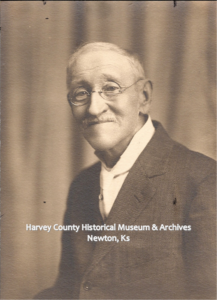
John B. Dickey, Sr, taken shortly before his death in 1921.
In 1879, he purchased a lot at 611 Main, Newton and built a new structure and for the next 50 years Dickey's Drug was a Newton fixture.
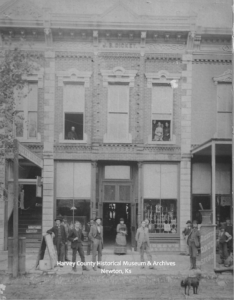
Dickey's Drug & Jewelry, 611 Main, Newton. 1883.
By the turn of the century, he had added jewelry to his stock.
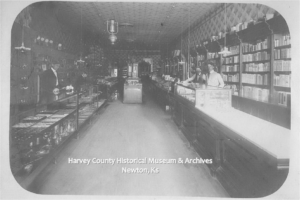
Interior, 611 Main, Newton, 1887.
In addition to running his business, he served on the Newton City Council and as Mayor. Many civic projects, including Newton's Country Club and two public parks, Military and Themian Parks, succeeded because of his"unfailing optimism."
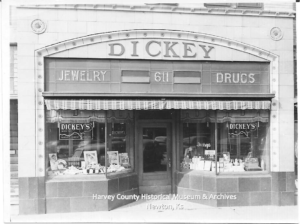
Dickey Drug & Jewelry, 611 Main, Newton, 1925.
In 1921, shortly before his death, he celebrated 50 years in business at 611 Main. J.B. Dickey died October 28, 1921.
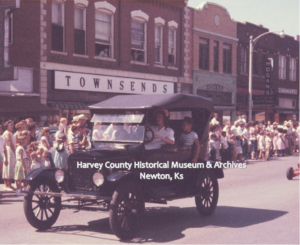
Dickey's visible in the background, 1950s.
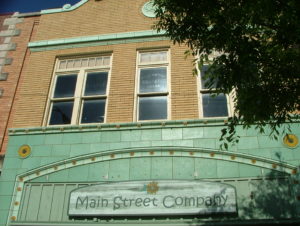
Main Street Co., 611 Main, Newton, 2007
Sources
- Evening Kansan Republican:28 October 1921, 29 October 1921, 31 October 1921.
- "Career of John B. Dickey" inThe Jewelers' Circular, Vol 83, Issue 2.16 November 1921.
- "New Member of the Jewelers Security Alliance"Jewelers' Circular & Horological Review, vol. 45 (17 September 1902) p. 44.
- Sapone, Jane."Presentation Boxes Tell A Story: J.B. Dickey Jeweler, Newton, Kansas." Thimble Collectors International, Summer 2014, p. 22.
Source: https://hchm.org/blog/voices-of-harvey-county/page/47/
0 Response to "Plantscape Fairview Collecting for Christmas Cards for Troops Again"
Post a Comment